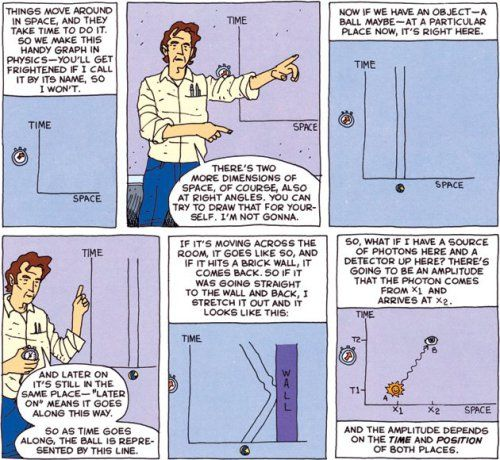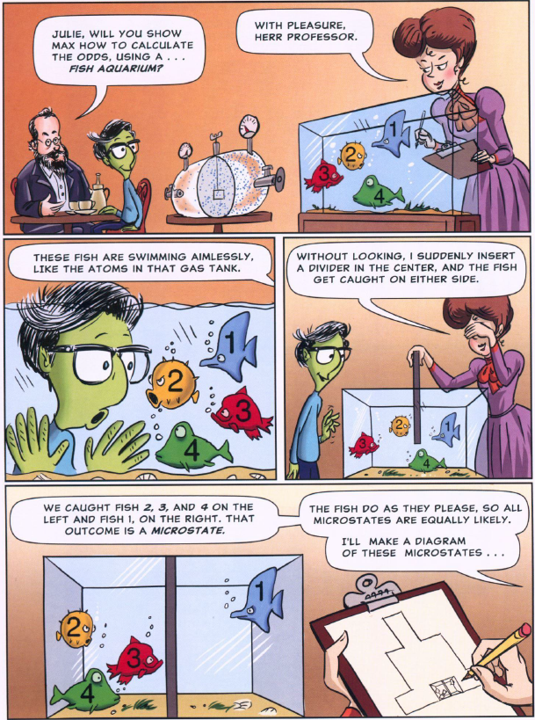Drawing Understanding
Teaching Physics with Graphic Novels
When thinking about the students in the back of our classrooms that are struggling and not naturally captivated by the course content, how can we invite them into a more holistic picture of science which includes the struggle, the messiness, and the humanity?
There’s a growing body of literature exploring the use of graphic novels in disciplines like English, history, and other humanities fields [1–4]. But when it comes to STEM—especially physics—their presence is far more limited.
I initially hesitated to see graphic novels as anything more than light reading. They felt too informal—too unserious—for the rigors of physics. The more time I’ve spent with them, the more I’ve come to see that graphic novels can offer significant depth. Under the right conditions, they can become holistic teaching tools, weaving together physics concepts, narrative, and history— ultimately bringing some humanity back into physics curriculum. As well, not all students are naturally drawn to science and physics, and textbooks are not likely to draw them in any further.
Why Graphic Novels?
Where traditional textbooks often struggle to capture students’ attention, graphic novels excel. Their multimodal nature—combining images, text, and narrative—can draw students in and make abstract or complex ideas feel more grounded and intuitive. They offer a narrative-driven way to introduce vocabulary, explain abstract ideas, and stir curiosity.
When used thoughtfully, graphic novels provide students with an alternate lens on difficult material, one that doesn’t compete with the formal structure of physics but instead complements it.
For example, I love this passage from Feynman, a graphic biography of Richard Feynman [5], in which he explains the principles of QED using spacetime diagrams. The visual narrative doesn’t dumb down the content—it invites students into it.

Graphic Novels in Practice: Two Approaches
I’ve experimented with incorporating graphic novels in two ways: as a one-off lab activity in an introductory physics course, and as a longer-term reading and discussion component in a small upper-level Modern Physics course.
Case 1: Exploring Entropy with Max the Demon vs. Entropy of Doom
Entropy is a famously challenging concept for undergraduates. To help students grapple with its multiple interpretations, I developed a 2-hour lab activity centered on different historical definitions: entropy as unavailable energy, as the “arrow of time,” as a statistical phenomenon, and of course, its mathematical formulation.
As part of the lab, students read excerpts from Max the Demon vs. Entropy of Doom, a graphic novel that uses humor and storytelling to explore thermodynamic concepts. I obtained permission from the authors to distribute PDF chapters via our course management system and also left a few hard copies in the lab.

Reading and discussing those chapters helped set the stage for deeper engagement. Coincidentally, the film Tenet had just been released in theaters, so the students were particularly animated when discussing the “arrow of time” interpretation.

The lab concluded with a hands-on simulation using dice to model entropy as a statistical phenomenon—adapted from a 2010 activity by Michael LoPresto [6]. Students tracked outcomes with 6-, 8-, and 12-sided dice to visualize increasing disorder and reinforce the probabilistic nature of entropy. A copy of the handout I developed can be found linked here.
“Why can’t all textbooks be comic books?” — One student’s reaction after finishing the graphic novel
While some students critiqued the artistic style (“it’s kind of cringe”), they generally appreciated the activity and seemed to come away with greater clarity and confidence around entropy.
Scaling this up for larger classes would pose challenges, and the activity focuses narrowly on a single concept. But as a self-contained lab, it worked well. I’ve used it several times over the past few years, and found it a valuable activity each time.
Case 2: Bohr’s Biography in a Modern Physics Course
In my 300-level Modern Physics class, I tried a more integrated approach. While covering quantum mechanics, I assigned Suspended in Language, a graphic biography of Niels Bohr developed in collaboration with the Niels Bohr Institute [7].
The class was small—just six students—which made it ideal for in-depth discussion. Once a week, we spent 20–30 minutes reflecting on the reading, guided by a set of discussion questions adapted from work by Allison Fleshman at Lawrence University [8] (originally created for a quantum chemistry course).
The graphic novel offered students a compelling narrative context for otherwise abstract content. As we moved through the development of quantum theory, they could situate figures like Pauli, Heisenberg, Dirac, and Schrödinger within a meaningful historical and personal arc. Rather than a string of disconnected names, the scientists became people—colleagues, rivals, mentors—with goals, tensions, and ethics.
This biographical framing allowed us to discuss deeper themes. Students picked up on the political and moral complexities of the era: the displacement of Jewish physicists fleeing Nazi persecution, the nuclear arms race, and the postwar push for disarmament. These weren’t tangents—they were contextual to the content we were learning.
Student feedback was overwhelmingly positive. They found the graphic novel both accessible and thought-provoking. One noted how “human” the content felt—something traditional textbooks rarely achieve.
Practical Considerations
Access was one of the trickier aspects of implementing these assignments. For the entropy lab, I secured permission from the authors to share select chapters via PDF. For Suspended in Language, I encouraged students to buy their own copies but also made my personal copy available in the lab and placed a second on reserve in the library.
Overall, neither activity was prohibitively difficult to set up, though larger classes would certainly complicate logistics.
Challenges and Limitations
The first challenge that comes to mind is time. Incorporating these discussions into the course takes up a lot of time that could be used for content. I find this a challenge particularly in my Modern Physics course where there is so much to cover. I’ve tried to keep conversations about the novel brief, and provided reflection questions beforehand to prime the discussion (modified from Allison Fleshman’s work [8]). Still, this takes up 15-20 minutes of classtime once a week, which can get eaten up fast if students don’t come prepared to discuss. I do wonder whether there could be a better way of implementing this in small student-led discussion groups.
The artwork and presentation can sometimes have the opposite effect— instead of engaging the student, I’ve had students before that have commented that they find the artistic style off-putting, or difficult to parse (particularly in the case of Suspended in Language).
The feedback collected from students is anecdotal, and only interrogates how they felt about the materials. While it seemed like the graphic novels engaged the students, I need to find ways to measure whether it helped their conceptual understanding.
Final Thoughts
Graphic novels are not a panacea for every challenge in teaching physics. But when used with intention, they can open up new avenues for engagement, reflection, and depth. They humanize scientific discovery, highlight the people behind the theories, and help students connect emotionally with content that might otherwise feel dry or inaccessible.
I’ve found that short, focused activities—like the entropy lab—are a great place to start. But the real potential, at least in my experience, comes through sustained engagement: discussions that give students room to respond, critique, and connect. Unfortunately, in the physics classroom, we often don’t have in-class time for this sustained engagement and are often haunted by the “tyranny of content” [9].
There’s something powerful about meeting students where they are, and sometimes that means taking a moment to put aside the textbook, and pick up a comic book instead.